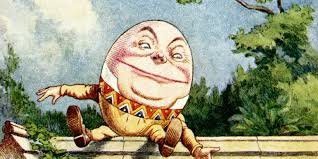When we think of the phrase “Humpty Dumpty,” the image of a large, egg-shaped character immediately comes to mind. However, the actual Humpty Dumpty meaning has more depth than just a nursery rhyme for children. While many of us have memorized the famous lines, “Humpty Dumpty sat on a wall, Humpty Dumpty had a great fall,” the origins of the character and its symbolism extend far beyond the tale of a clumsy egg falling off a wall.
The meaning of Humpty Dumpty has been debated for centuries. Some believe that it’s simply a fun rhyme for children, while others argue it has more historical and symbolic significance. In this blog post, we’ll take a deeper look into what Humpty Dumpty represents, explore its background, and try to uncover the hidden story behind the rhyme.
Humpty Dumpty Meaning: A Deeper Look Into Its Origins
The Humpty Dumpty meaning that most people are familiar with centers around the image of an egg-like figure. But why an egg? Interestingly, the rhyme itself doesn’t mention anything about Humpty Dumpty being an egg. So, how did this association come about?
One theory suggests that Humpty Dumpty was originally a representation of something much more symbolic. In 17th-century England, “Humpty Dumpty” was a slang term for a clumsy person, often someone who could easily fall or fail. This fits with the imagery of a character sitting high on a wall and experiencing a sudden, great fall. The egg interpretation is believed to have been popularized later by illustrators like John Tenniel in the 19th century, who depicted Humpty Dumpty as an egg in Lewis Carroll’s Through the Looking-Glass.
Another theory is that Humpty Dumpty represents the downfall of something or someone important. Some historians suggest that the rhyme may be an allegory for the fall of a monarch or leader, symbolizing how certain figures, once they lose their power, cannot be “put back together” again, regardless of how much help they receive.
Historical Significance of the Humpty Dumpty Meaning
The Humpty Dumpty meaning also has possible historical connections. One famous interpretation links the rhyme to the English Civil War in the 17th century. According to this theory, Humpty Dumpty was a powerful cannon used by Royalist forces during the Siege of Colchester in 1648. Positioned on a wall, this cannon is said to have caused significant damage to the Parliamentarian forces. However, the cannon eventually fell off the wall, and despite efforts to repair it, it could not be restored to working order—hence, the phrase “All the king’s horses and all the king’s men couldn’t put Humpty together again.”
While there is no definitive proof that the nursery rhyme refers to this historical event, the meaning of Humpty Dumpty is open to various interpretations. The cannon theory remains a popular one, particularly for those interested in English history.
Humpty Dumpty Meaning in Modern Culture
In modern times, the Humpty Dumpty meaning has evolved beyond its historical and literary origins. Today, the phrase “Humpty Dumpty” is often used metaphorically to describe someone or something that has fallen from grace or a situation that is beyond repair. For example, when a person experiences a significant failure, especially one that cannot be fixed, they might be compared to Humpty Dumpty.
This Humpty Dumpty meaning has also found its way into popular culture. The character of Humpty Dumpty has been referenced in movies, television shows, and books as a symbol of fragility and the idea that some things, once broken, cannot be mended. It serves as a cautionary tale for children and adults alike, reminding us that actions can have irreversible consequences.
The Symbolism of Humpty Dumpty Meaning
One of the key aspects of the Humpty Dumpty meaning is its symbolism of fragility. Humpty Dumpty represents not just physical fragility but also emotional and societal fragility. Just like the nursery rhyme’s egg-shaped character who could not be repaired after falling, the phrase symbolizes how certain breaks or failures cannot be undone, no matter how much effort is applied.
This idea of fragility can apply to many areas of life—relationships, political power, or even personal reputation. The Humpty Dumpty meaning serves as a metaphor for any situation where, once something is broken, it can never return to its original state. This can be an important lesson for young children learning about actions and consequences, as well as for adults reflecting on the irreversible nature of certain decisions.
Humpty Dumpty Meaning: Lessons and Takeaways
The Humpty Dumpty meaning teaches us about the consequences of fragility and failure. Whether it refers to historical events or simply serves as a lesson for children, the rhyme carries a powerful message. It reminds us that some things in life, once broken, cannot be fixed. This lesson can be applied to personal relationships, careers, or even political power.
In today’s world, where we are constantly striving to build and achieve, the meaning of Humpty Dumpty encourages us to think about the consequences of our actions. Just like the figure in the nursery rhyme, sometimes a fall—literal or figurative—can be final, no matter how much help is available.
Read more: Caroline Ellison: The Journey of a Financial Prodigy in the Cryptocurrency World
FAQs About Humpty Dumpty Meaning
The Humpty Dumpty meanings is often interpreted as a cautionary tale about fragility and irreversibility. While popularly depicted as an egg, it symbolizes situations where something, once broken, cannot be fixed, regardless of effort.
Although the character is commonly depicted as an egg, the original rhyme does not specify this. The association with an egg became popular due to illustrations in later literary works.
Some historians believe that Humpty Dumpty could be linked to events during the English Civil War, specifically a cannon that fell during the Siege of Colchester. However, there is no definitive evidence to confirm this.
In modern culture, Humpty Dumpty is often used as a metaphor for something fragile or a situation that cannot be repaired once broken. It represents irreversible failures or falls from grace.
The egg-like depiction of Humpty Dumpty became popular through illustrations, especially in Lewis Carroll’s Through the Looking-Glass. These illustrations cemented the idea of Humpty Dumpty as an egg.
Conclusion
The Humpty Dumpty meaning has evolved from a simple nursery rhyme to a symbol of failure, fragility, and the irreversible nature of certain actions. Whether viewed through the lens of history, literature, or modern culture, Humpty Dumpty continues to serve as a reminder that some things, once broken, can never be fully repaired. As we navigate our own lives, this timeless tale encourages us to think carefully about our decisions and the potential consequences that may follow.





